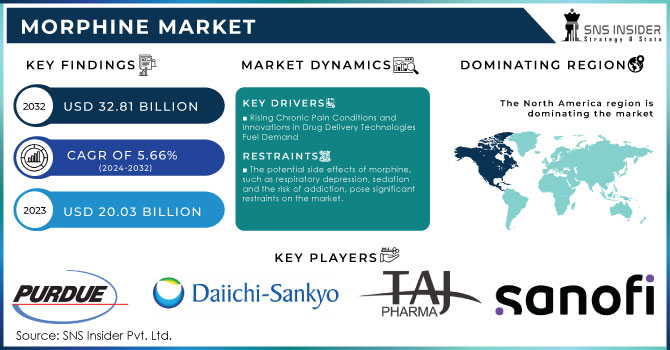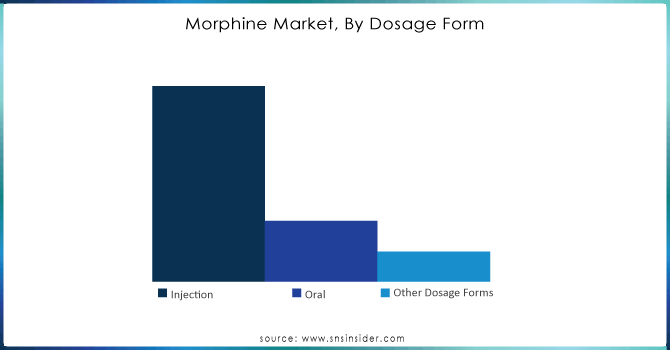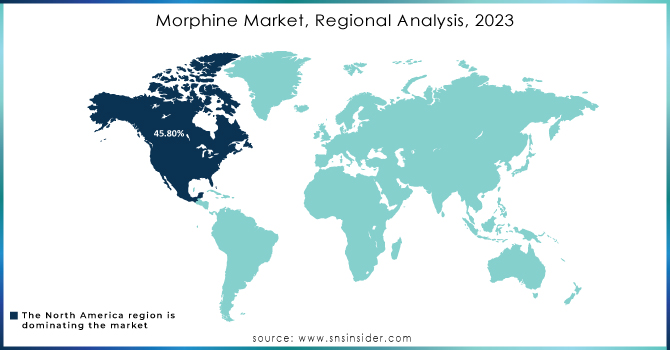Morphine Market Report Scope & Overview:

Get more information on Morphine Market - Request Sample Report
The Morphine Market Size was valued at USD 20.03 billion in 2023 and is expected to reach USD 32.81 billion by 2032 and grow at a CAGR of 5.66% over the forecast period 2024-2032.
Increasing incidences of medical conditions characterized by pain and an increasing geriatric population would fuel growth prospects in the morphine market. Morphine is an opiate analgesic, obtained from the opium poppy plant i.e. Papaver somniferum, one of the cornerstones in the treatment of cancer, musculoskeletal disorders, and postoperative pain. According to the Centers for Disease Control and Prevention, in 2020, more than half a billion people around the world were suffering from osteoarthritis, indicating the utmost necessity for proper pain relief treatment. The geriatric population is more susceptible to chronic pain and diseases such as arthritis and comprises the major market for morphine. A study published in May 2021 reveals that over half of the geriatrics suffer from chronic pain. This has naturally increased the consumption of potent painkillers like morphine. Based on a prediction made by the Arthritis Society of Canada, close to 50% of the elderly population more than 65 years of age suffers from arthritis, which will propel the demand for morphine as a prime pain killer.
The WHO also announced in February 2021 that about 1.71 billion people were suffering from musculoskeletal disorders. It is a pretty alarming number that underscores pain management techniques' urgency, and therefore morphine becomes an integral part of the treatment protocols. This is a positive shift in the market due to higher governmental support for opioids in the health sector, particularly in developing markets. Legitimization can spur the ease of availability and acceptance of morphine as a necessary prescription drug. The pharmaceutical company is very heavily investing in the drug as it allows them to expand its use in other new pharmaceutical drugs for a range of diseases including appetite stimulation, resolution of inflammation, and psychiatric conditions.
The morphine market will grow despite the probability of abuse and addiction due to technological improvements in pain management and an increasing focus on palliative care. Even as healthcare professionals continue to develop priorities in effective relief from pain, morphine remains one of the essential drugs in improving the quality of millions suffering from severe pain.
Morphine Market Dynamics
Drivers
-
Rising Chronic Pain Conditions and Innovations in Drug Delivery Technologies Fuel Demand
The main drivers of the morphine market are the rising prevalence of chronic pain conditions, including cancer, musculoskeletal disorders, and neuropathic pain. The WHO has an estimate about the growing incidence of cancer, almost increasing by 50% in the next two decades, which will require better solutions to manage the pain. This increase in chronic pain disorders has increased the need for effective analgesics like morphine, critical for the relief of severe pain and improvement in the quality of life for these patients.
Advances in drug delivery technologies have also contributed to the growth of the morphine market. The latest and innovative formulations and modes of delivery have enhanced the efficacy and safety of morphine administration. In this respect, a research article published in the Journal of Pain Research in 2022 presents the development of sustained-release patches of morphine which are designed to impart protracted relief from pain and to minimize systemic side effects. Such technological developments ensure not only better adherence on the part of patients but also enhanced clinical outcomes, which can feed into and fuel demand for morphine as a practical pain management option.
All these trends suggest exponential growth in the morphine market as the healthcare community tackles the growing burdens of chronic pain and pushes forward with enhanced drug delivery technologies to enable the patients.
Restraints
-
The potential side effects of morphine, such as respiratory depression, sedation, and the risk of addiction, pose significant restraints on the market.
-
The morphine market is significantly impacted by strict regulations imposed by governments and healthcare authorities aimed at reducing the risks of opioid misuse, addiction, and overdose.
Morphine Market - Key Segmentation
by Dosage Form
The injection dosage form of the morphine market dominated the market in 2023, with a huge share of about 70%. Generally, the reason for this dominance is that injections deliver rapid effectiveness for long periods and hence dominate the choices of various healthcare providers treating acute and chronic pain in patients. Contributing to the ever-increasing demand for injectable morphine preparations is the growing incidence of neurological diseases, which are often complicated with significant and chronic pain.
Although the injection segment is market-leading, the oral dosage form is picking up and may most likely be the fastest-growing segment during the forecast period. This can be a result of oral medications being preferred due to easy administration and patient compliance. As healthcare professionals seek the most effective forms of pain management, both injectable and oral morphine has potential uses to fill in the international need for analgesia.

Need any customization research on Morphine Market - Enquiry Now
by Application
In 2023, the biggest application for morphine was pain management with a market share close to 80%. Most applications of morphine directly relate to the treatment of various severe types of pain, such as chronic pain conditions, postoperative pain, and cancer-related pain. The increasingly growing orthopedic disorders and geriatric population who are prone to suffer from chronic pain increase the demand for morphine in the context of pain management.
The cold and cough suppressant segment is expected to be the fastest-growing application through the forecast period. This growth can be accredited to the rising awareness of morphine's efficiency in alleviating severe cough symptoms associated with respiratory infections and other illnesses. As healthcare providers begin to realize that proper symptom management is one of the important aspects of patient care, demand for morphine will most surely increase as an effective treatment for those patients suffering from colds and coughs in their daily lives, showing a transition toward integrated therapeutic use in clinical practice.
Morphine Market Regional Analysis
The North American morphine market accounted for a huge share of 45.80% in 2023, mainly due to the presence of major players, the huge prevalence of chronic diseases, and a developed healthcare setup. The morphine market in the U.S. will primarily be driven by well-established medical practices and the continuously increasing demand from their client base for pain management solutions. On the other hand, the most rapid growth was reported in Canada, reflecting the growing acceptance of treatments to control pain, as well as government policy promoting opioids as prescription medications within the clinical settings.
The morphine market in the Asia-Pacific is poised to experience immense growth between 2024 and 2032. Some of the factors that drive this growth include the rising prevalence of chronic diseases, such as cardiovascular diseases. Although China will grow the fastest due to its huge population and greater accessibility to advanced medical treatments, it will consume the highest share of the region's market. Besides, the growth in the Indian morphine market is further boosted by rising healthcare costs and heightened awareness of pain treatments both among patients and healthcare providers.

Key Manufacturers of Morphine Drugs
-
Purdue Pharma
-
Daiichi Sankyo Inc.
-
Taj Pharmaceuticals Limited
-
Sanofi Winthrop Industries
-
Mayne Pharma Group Limited
-
Sun Pharmaceutical Industries
Key Suppliers of Raw Morphine
-
Manus Aktteva Biopharma LLP
-
Macfarlan Smith
-
Qinghai Pharmaceutical
-
Northeast Pharmaceutical Group
-
Alcaliber
-
Johnson Matthey Fine Chemicals
Recent Developments
In Aug 2024, The FDA approved the Zurnai (nalmefene injection) auto-injector, designed for the emergency treatment of known or suspected opioid overdoses caused by both natural and synthetic opioids in adults and pediatric patients aged 12 years and older.
In May 2024, Purdue Pharma L.P. entered into an agreement aimed at providing low-cost treatment options for opioid use disorder within correctional facilities. This initiative seeks to address the needs of incarcerated individuals struggling with opioid addiction, thereby enhancing access to essential treatment and supporting efforts to combat the opioid crisis.
| Report Attributes | Details |
|---|---|
| Market Size in 2023 | USD 20.03 Billion |
| Market Size by 2032 | USD 32.81 Billion |
| CAGR | CAGR of 5.66% From 2024 to 2032 |
| Base Year | 2023 |
| Forecast Period | 2024-2032 |
| Historical Data | 2020-2022 |
| Report Scope & Coverage | Market Size, Segments Analysis, Competitive Landscape, Regional Analysis, DROC & SWOT Analysis, Forecast Outlook |
| Key Segments | • By Dosage Form (Injection, Oral, Other Dosage Forms) • By Application (Pain Management, Diarrhea Suppressant, Cold & Cough Suppressant, Others) • By Distribution Channel (Hospital Pharmacies, Retail Pharmacies, Online Pharmacies, Others) • By End User (Hospitals & Clinics, Ambulatory Surgical Centers, Others) |
| Regional Analysis/Coverage | North America (US, Canada, Mexico), Europe (Eastern Europe [Poland, Romania, Hungary, Turkey, Rest of Eastern Europe] Western Europe] Germany, France, UK, Italy, Spain, Netherlands, Switzerland, Austria, Rest of Western Europe]), Asia-Pacific (China, India, Japan, South Korea, Vietnam, Singapore, Australia, Rest of Asia-Pacific), Middle East & Africa (Middle East [UAE, Egypt, Saudi Arabia, Qatar, Rest of Middle East], Africa [Nigeria, South Africa, Rest of Africa], Latin America (Brazil, Argentina, Colombia, Rest of Latin America) |
| Company Profiles | Manus Aktteva Biopharma LLP, Macfarlan Smith, Qinghai Pharmaceutical, Northeast Pharmaceutical Group, Alcaliber, Verve Health Care Ltd., Johnson Matthey Fine Chemicals, and Pfizer Inc. |
| Key Drivers | • Rising Chronic Pain Conditions and Innovations in Drug Delivery Technologies Fuel Demand |
| Restraints | • The potential side effects of morphine, such as respiratory depression, sedation, and the risk of addiction, pose significant restraints on the market. • The morphine market is significantly impacted by strict regulations imposed by governments and healthcare authorities aimed at reducing the risks of opioid misuse, addiction, and overdose. |

